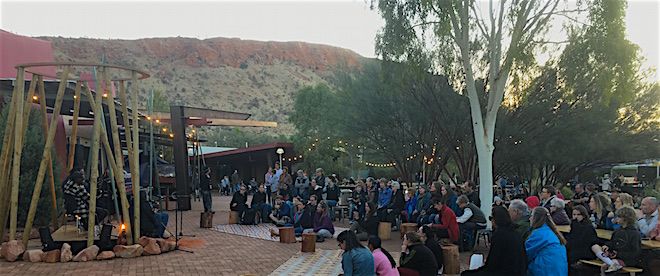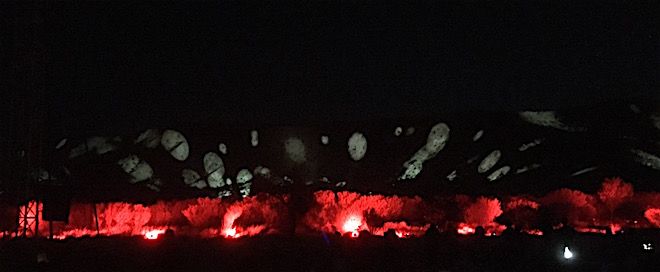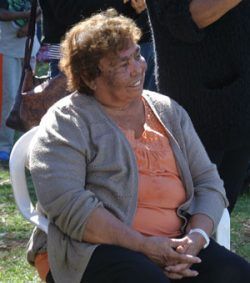Conflicting stories for Parrtjima’s lights on the hill
3 October 2017

Above: Custodians, on stage at the left, speak to Parrtjima visitors about what the festival has meant to them. Behind them, the range, the peak of which can be glimpsed through the trees.
By KIERAN FINNANE
Modified 4 October 2017
See also UPDATE at bottom.
They made it clear: speaking on stage in Parrtjima’s Knowledge Program four Arrernte custodians gave a big thumbs up to the Festival in Light on its last night. They said it honoured and respected their culture, they thanked the organisers for having spoken to all the right people and they looked forward to it continuing.
Equally clear, in her home on the other side of town apmereke-artweye Doris Kngwarraye Stuart said the lights on the range disrespect it as a sacred site, she has not been listened to by the organisers and she wants the festival in its present form to end. Mrs Stuart is well-known for her persistent campaigning over many years to protect sacred sites.
The Arrernte term apmereke-artweye can be understood as ‘owners of an estate’, in this case Mparntwe which is Peltharre/Kngwarraye country.
The apmereke-artweye take care of the estate in partnership with others known as kwertengerle. The English term “boss” is sometimes applied to both roles (see note at bottom). The four custodians who spoke at Parrtjima also describe themselves as apmereke-artweye and kwertengerle.
 At Parrtjima the first to speak was Peter Peltharre Wallace: “We’re all very happy with this light show here in Alice Springs, Central Arrernte country. We showed our young ones, introduced tourists as well.”
At Parrtjima the first to speak was Peter Peltharre Wallace: “We’re all very happy with this light show here in Alice Springs, Central Arrernte country. We showed our young ones, introduced tourists as well.”
Left: Front, Mr Wallace speaking; from left, Mrs Hayes, Mr Stevens, Mr Williams.
He was followed by Baydon Mpetyane Williams, who introduced himself as a Western Aranda man, “a ceremonial leader in my tribe”, and “a custodian of Mr Wallace and Mr Stevens”.
“We are always learning from senior Elder men,” he said. “It’s not like when we go through ceremony we know it all, nah, we’re learning off them every day, all the time, learning, learning and learning.”
He had seen the light show for the first time the previous night: “It just blew me away.”
Benedict Kngwarraye Stevens has been closely involved for some time. It is his voice that welcomes visitors to country in Arrernte and English as part of the soundscape that accompanies the light show.
He offered a “big thank you” to the organisers for “going around looking for the right people” to give cultural grounding to the festival.
“When I first came here, I was proud, lighting up my country, plus my hills,” he said with a big smile.
Felicity Hayes welcomed the opportunity Parrtjima offered: “If we are to live as Australians we should all be sharing our culture … Come and listen to the stories of the land, Alice Springs is a very rich place for cultural history.
“We teach our children as well, even the non-Indigenous children so we can all live in harmony.”

Above: One scene from the light show. The red lit bushes are in the foreground.
The light show this year has avoided explicit references to traditional stories, evoking elements of country and seasonal changes and general cultural strength. Mr Wallace, however, told the small gathering at the Knowledge Program that “these MacDonnell Ranges is Yeperenye, Caterpillar Dreaming that comes from the west through here over to the east.”
Mr Stevens was also explicit: “That hill there, Caterpillar, that’s my totem, that’s my Dreaming. Yeperenye, Caterpillar. So I’m a Caterpillar totem.”
This reference to the Caterpillar story is just one of the things that offends Mrs Stuart. She is adamant that the story for the range west of Ntaripe (the Gap) to Alhekulyele (Mount Gillen) is the Wild Dog, Akngwelye.
This is in keeping with the account given by custodians in the 1980s to David Brooks and published by IAD Press in 1991 as The Arrernte Landscape (later renamed and reprinted as A Town Like Mparntwe: a guide to the Dreaming tracks and sites of Alice Springs).
The families involved were the Stevens, Stuarts and Rices, as well as the late W. Rubuntja, M. Conway and H. Ross. Mr Brooks particularly mentions the work begun by the late T. Stevens, father of Benedict Stevens, in documenting the damage to sites.
This is how the book puts it: “As well as Ntaripe, most of the features of the Mt Gillen Ridge (including the peak Alhekulyele) were formed by the activities of the wild dog. Indeed, much of the west side of Alice Springs has this association.”
 “That was never Caterpillar, never,” Mrs Stuart told Alice Springs News Online. “That’s why I didn’t agree with any of that going on there from the start.”
“That was never Caterpillar, never,” Mrs Stuart told Alice Springs News Online. “That’s why I didn’t agree with any of that going on there from the start.”
Left: Mrs Stuart at NAIDOC festivities in 2015, featuring a re-enactment of the Wild Dog story. Photo from our archive.
She said she made this clear to Parrtjima organisers last year and as long as they persist in wanting to light up the range in this area, a sacred site, she will have nothing to do with them.
She objects to the very notion of light projection (“a breathtaking illumination”) onto “a 300-million-year-old natural canvas”, as the publicity for Parrtjima puts it.
“That’s not a blank canvas! They’re putting stories there that don’t belong there, they’re taking someone else’s story and putting it there.”
If the organisers had proposed working with the Dog story, how would she feel?
In short, just as adamantly opposed: “That story is protected and shouldn’t be out there.”
After the presentation at Parrtjima, the News put questions about Mrs Stuart’s objections to two of the custodians, Mr Stevens and Mrs Hayes.
What is the answer when Doris Stuart says it is wrong to shine lights on the hill?
“It’s just lights, hey, lighting up our country,” said Mr Stevens.
“Sharing culture,” added Mrs Hayes.
“Yes, we’re sharing with the rest of the world,” said Mr Stevens. “I think it’s better off sharing. You go to other countries, they share their story. Alice Springs is a centre for tourists so we need to share it.”

Above: The range in darkness looming above the Desert Park where lights were on for the Honouring Space (Iltja Ntjarra / Many Hands Art centre ) in the foreground.
The News put to them that Mrs Stuart thinks sharing can be done in a quiet way, with the story and respect for the sites. She sees the light show as disrespectful of the site.
“People burn trees, hey, that’s not a respect,” said Mr Stevens.
“Down the Todd, people burn trees,” joined in Mrs Hayes. “Those trees are nearly 200 years old and they’re sacred trees. That’s being disrespectful and nobody’s come out and said anything about it.
“The lights are not burning or anything. They’re just showing people about culture … People from around the world may be coming to see it, what Aboriginal people’s country is all about.”
The message is not just for interstate and international visitors, said Mr Stevens, but for people living in the communities surrounding Alice Springs: “We need you guys coming into town, especially our country, the Arrernte country, Alice Springs, we need to be respected. That’s my point of view.”
The News put to them that the range is Dog story.
“That’s the end of it, said Mr Stevens.
“The end part of it,” said Mrs Hayes, referring to the peak of Mt Gillen which remains in darkness during the light show.
Mrs Stuart had told the News that from the gap to the end it’s Dog, Caterpillars might come here and there in pockets, but she said it’s wrong to talk about the range as Caterpillar story.
Said Mr Stevens: “It wasn’t even mentioned today, the Dog. We don’t talk about that. The lights weren’t shining towards the Dog. [The lights are] in the middle. Us Elders have granted that permission. But not the Dog end. She’s got different views.”
Mrs Stuart does not accept that the Dog can be separated off like this: “That story is still the same story, from there [the peak] right to the gap. All the way. Like my toe is connected to my foot, my foot to my knee, same story. You can’t put any other stories there …
“I don’t know any other story for that area. All I know is the Dog. It doesn’t matter that [the light is] away from the hill. It’s still his territory, where that battle went on. It’s been recorded, that’s why the little book [referred to above] was put through … that’s why we did that 30-odd years ago, the family.”
The News asked Mr Stevens and Mrs Hayes, how this works traditionally. Is it possible to have these different views without it causing trouble?
 Mr Stevens replied: “Permission was granted by the Elder Arrernte men for this to happen.”
Mr Stevens replied: “Permission was granted by the Elder Arrernte men for this to happen.”
Left: Mr Wallace asked the audience to “spread the news” about “this magnificent light show”.
Are they apmereke-artweye for this site?
“We all are,” said Mrs Hayes.
“We are all apmereke-artweye and all the kwertengerles. It was gone through the proper procedure,” said Mr Stevens.
Without wanting to be disrespectful to them, the News asked what they had to say to the suggestion, including by Mrs Stuart, that they are being paid and that is why they are going along with the light show?
“It’s just a new generation. That’s how it is nowadays. We can’t just do it for free,” said Mr Stevens. He declined to say how much he was being paid: “Is that important?” he asked.
Well, did he consider they were being paid fairly for giving information about their culture?
“Yes. But I won’t tell the amount.”
Said Mrs Hayes: “We give all the information, our cultural information so people know about it, what stories are here. There are a lot of people who don’t know anything about Aboriginal people, they just come in and see us as [she searches for the words] bad people, drinkers, you know, bludgers, what not.
“That’s what we get labelled all the time but we want to show what’s in us, what we are really as Aboriginal people. We don’t want people to see us as negative all the time. We want to show them that we got culture. We want to share it with the people.”
Would they like Mrs Stuart to support Parrtjima?
“It’s up to her to decide,” said Mr Stevens.
Mrs Hayes: “Certainly, I think so. We all agree on it. We want to support it.”
Mr Stevens: “We can support each other.”
Mrs Hayes: “There’s nothing wrong … people come out and enjoy themselves … I reckon she should support us, hey?”
That won’t be happening. Mrs Stuart’s opposition to the whole Parrtjima concept is implacable:
“It’s a sacred hill! We’re not allowed to climb up there! Who gives the people the right to shine a light on it when we can’t climb up there, just out of respect, for fear of what might happen to our generations afterwards.”
She will continue doing her work to share culture and protect sites in the way she sees fit – from time to time hosting tours of sacred sites, supported by Watch This Space and particularly Dan Murphy and Lucy Stewart, and working with artists to raise awareness and promote respect for the sites. She will be curating an exhibition of work developed out of this process, titled Alice to Mparntwe, which will show at Watch This Space in November.
UPDATE, 4 October, 2017, 1.20pm:
Greg McAdam, Arrernte man, who participated in Parrtjima’s Knowledge Program, comments on the issues of remuneration for cultural knowledge:
“Aboriginal people with knowledge have an important part to play in bringing the two worlds, Aboriginal and non-Aboriginal, together.
“Their knowledge is their cultural capital and it should be remunerated just like everyone else gets remunerated for their knowledge and skills.
“For many Aboriginal people this could provide a way out from living on welfare.
“This is about a whole range of dedicated Arrernte people being proud of who they are and wanting to show the world.”
See last week’s article for more detail on the talk Mr McAdam gave at the Parrtjima festival hub.
FOOTNOTE:
The explanation of these terms is sourced from the outline of Arrernte social organisation contained in the determination of Native Title over the Alice Springs area, Hayes v Northern Territory, which can be found here.



Why shouldn’t Elders be paid for their consultancy work? Any other person providing professional advice in any other profession would charge a consultancy fee – and a steep one at that! $$. These Elders are constantly humbugged by Government and Organisations in Alice Springs because of their status as key owners and caretakers. Government and Org’s do not see or live the stress these Elders have to deal with that exists in the Aboriginal landscape here. These leaders are torn down and heavily criticised within this community by their own people, and also by Government or non-Aboriginal people who want them to make immediate decisions about events, festivals, land developments etc. This is why even the simplest of decisions about land or development is a major issue.
We should be applauding Apmereke-artweye Benedict Stevens and Kwertengwerles Coco and Felicity for engaging with this highly contentious process.
Thank you Kieran for (dare I say it) an illuminating report. Your good work provides many insights into circumstances here affecting local people in our midst of which many of us – myself included – are often only dimly aware.